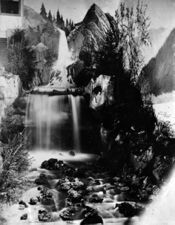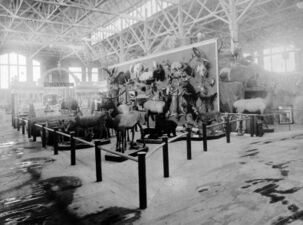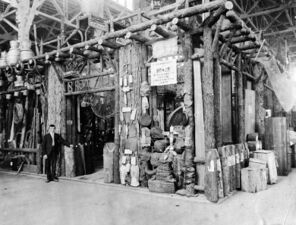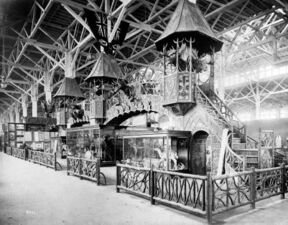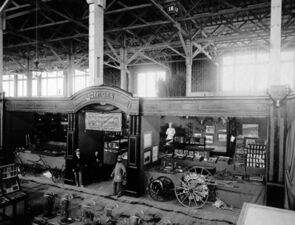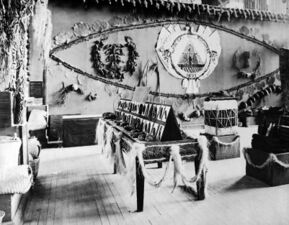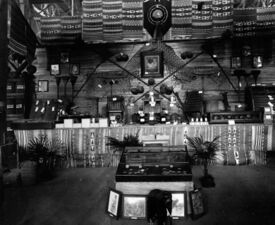Palace of Forestry Fish & Game: Difference between revisions
No edit summary |
No edit summary |
||
| Line 21: | Line 21: | ||
| special_day = | | special_day = | ||
| other = | | other = | ||
| floorplan_image = FP-Palace of Forestry.jpg | |||
| ticket_image = | |||
}} | }} | ||
The Palace of Forestry, Fish & Game was the smallest official Palace. Located in the [[Agriculture Area]], near the [[Place of Nations]], the building showcased displays of outdoor hunting and fishing. | The Palace of Forestry, Fish & Game was the smallest official Palace. Located in the [[Agriculture Area]], near the [[Place of Nations]], the building showcased displays of outdoor hunting and fishing. | ||
Revision as of 06:38, 4 December 2022
 | |
| Location | Agriculture Area |
|---|---|
| No. of Buildings | 1 |
| Construction | |
| Construction Cost | $171,000 ($5.16 million in 2021) |
| Architecture | |
| Architect | E.L. Masqueray |
| Dimensions | 300' x 600' |
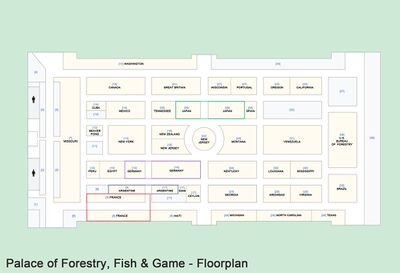 | |
The Palace of Forestry, Fish & Game was the smallest official Palace. Located in the Agriculture Area, near the Place of Nations, the building showcased displays of outdoor hunting and fishing.
Before the Fair
Description
The interior of the building was divided into five great naves extending through it's full length, the center nave being 85' wide. Ample light was given by the windows which occupied the greater portion of each of the four enclosing walls and by monitor windows inserted at frequent intervals in the roof. You could see 20 foot long snake skins to canning techniques to preserve fish. Taxidermy exhibits were quite numerous.
Notable Displays
Camp Adirondack
New York's display in the Palace was Camp Adirondack, built of spruce logs. The cracks are chinked with moss. The roofing is of spruce bark cut and laid in great squares. The long narrow window which admits an abundance of light to the interior is parallel with the logs. The interior is fitted in accordance with the tastes and customs of hunters. One end of the single room, for there is no division of the interior, is occupied by the great fireplace with its dressing of boughs above the mantel. The two bunks have framework of polished black spruce. They are furnished with mattresses made of balsam boughs and covered with bright red blankets, adding to the general appearance of cheerfulness. Deer, fox and bear skins are scattered on the floor and hung upon the walls. Guns hang upon the racks. The rods of the fisherman are stacked in the corners. Trophies of hunting and fishing are numerous. The furnishing and equipment are such as to inspire an immediate desire for an outing in the woods. Outside of the cabin are grouped the deer. The branches of a tree are occupied by the birds of New York. In and about a hollow tree trunk are squirrels and raccoons and rabbits.
Colorado
Colorado showcased a typical mountain cabin and a miniature mountain serve for the installation of taxidermy big game and birds of the Mountain State. In connection with these exhibits is shown an array of the woods from the parks and forests of the Rockies.
Brazil
Brazil exhibited a large variety of trees and woods including 83 types of bark. Rubber trees and giant emperor moths also graced their exhibit. The exhibit included huge balls of pure rubber, the milk white color of the sap having been changed by the smoke of the outdoor fire used to coagulate it. Brazil showed off an emperor moth that was 1- inches from tip to tip, and "the living leaf", and insect whos wings resembled the leaves of native bushes.
Canada
Canada showed a variety of game from their country including eight live beavers. After the fair, the beavers were purchased by New York and released in the Adirondacks.
Japan
Japan showed a life-sized silk screen painting of two Bengal tigers walking in the snow. This won a gold medal display award.
Funstein Bros
A large display, consisting of 1,600 feet of floor space was occupied by the Funstein Bros of St. Louis. They displayed skins, furs, mounted and unmounted, rugs of animal skins, game trophies, and animal traps. Other interesting displays in this section were a collection of flashlight pictures of wild deer by George Shiras, an exhibit of animal paintings by Alexander Pope, Taxidermy under convex glass by H.L. Rand, a collection of butterfly mounts by C.B. Riker, and a collection of Indian Relics presented by Chris Miller.
Weapons
There was a huge historical weapons exhibit at the western end of the palace. The collection included: blunderbusses, flintlocks and bow guns, to state of the art breach-loading army rifles. The highlight of the exhibit was a 400 year old Cookson gun inlaid with silver and gems. The collection was valued at $50,000 ($5.16 million today).
Gallery
-
Alaska
-
Alaska
-
Camp Adirondack
-
Colorado
-
Montana
-
Roosevelts Cabin
-
Brazil
-
Canada
-
Germany
-
Bust of Emperor William
-
Close-up Bust of Emperor William
-
Honduras
-
Siam
-
Funstein Bros
